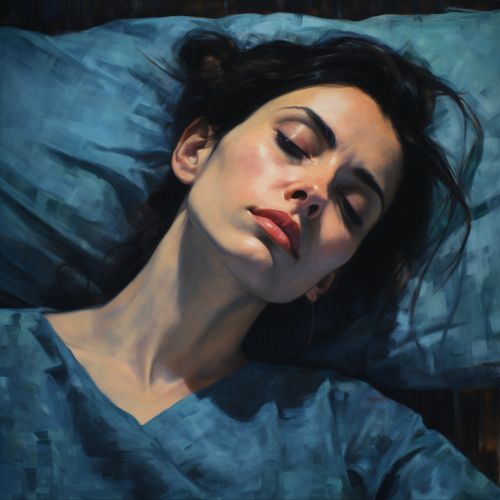Sleep disorder
Overview
A sleep disorder, or somnipathy, is a medical condition that negatively affects a person's sleep patterns. These disorders can be serious enough to impact a person's overall health, emotional well-being, and performance in daily activities. Sleep disorders are prevalent in society, with millions of individuals worldwide diagnosed with some form of sleep-related ailment.
Classification
Sleep disorders are broadly classified into six main categories: insomnia, sleep-related breathing disorders, hypersomnolence, circadian rhythm sleep-wake disorders, parasomnias, and sleep-related movement disorders.
Insomnia
Insomnia is characterized by persistent difficulty falling asleep or staying asleep, despite having an adequate opportunity to sleep. It can be either acute, lasting one night to a few weeks, or chronic, occurring at least three nights a week for three months or more.
Sleep-Related Breathing Disorders
Sleep apnea, a common sleep-related breathing disorder, is characterized by repeated episodes of significant reductions in airflow (hypopnea) or complete pauses in breathing (apnea) during sleep. This is often associated with a reduction in blood oxygen saturation.
Hypersomnolence
Hypersomnia or hypersomnolence disorders involve excessive sleepiness, characterized by recurrent episodes of excessive daytime sleepiness or prolonged nighttime sleep.
Circadian Rhythm Sleep-Wake Disorders
Circadian rhythm sleep-wake disorders are a family of sleep disorders affecting the timing of sleep. People with these disorders have sleep times that are out of alignment with the typical sleep-wake cycle.
Parasomnias
Parasomnia refers to abnormal behaviors or experiences that occur during entry into sleep, within sleep, or during arousals from sleep. These include nightmares, sleepwalking, and REM sleep behavior disorder.
Sleep-Related Movement Disorders
Restless legs syndrome and periodic limb movement disorder are examples of sleep-related movement disorders. They are characterized by simple, often repetitive movements during sleep.
Causes
Sleep disorders can be caused by a variety of factors. These include physical (such as lung disease), psychiatric (such as depression and anxiety disorders), and environmental (such as life events or shift work).
Diagnosis
Diagnosis of sleep disorders usually involves a combination of medical history, physical examination, and specific sleep studies. The most common sleep study is the polysomnography, which monitors several body functions including brain (EEG), eye movements (EOG), muscle activity or skeletal muscle activation (EMG), and heart rhythm (ECG) during sleep.
Treatment
Treatment of sleep disorders generally can be grouped into four categories: behavioral/psychotherapeutic treatments, rehabilitation/management, medication, and somatic treatments. The choice of a specific treatment depends on the patient's diagnosis, medical and psychiatric history, and preferences, as well as the expertise of the treating clinician.
Epidemiology
Sleep disorders are common in both children and adults. It is estimated that 50 to 70 million Americans chronically suffer from a disorder of sleep and wakefulness.
See Also


